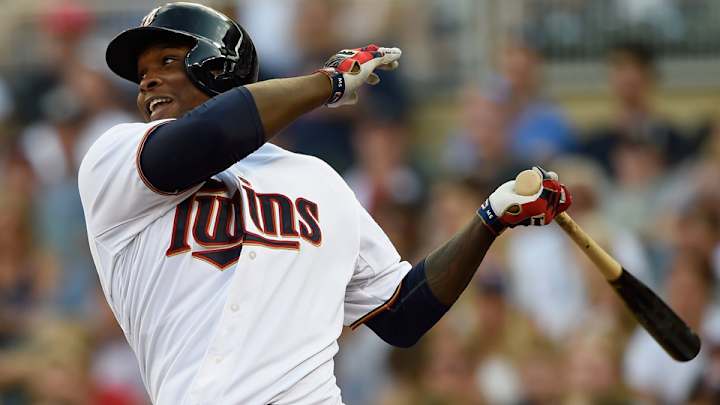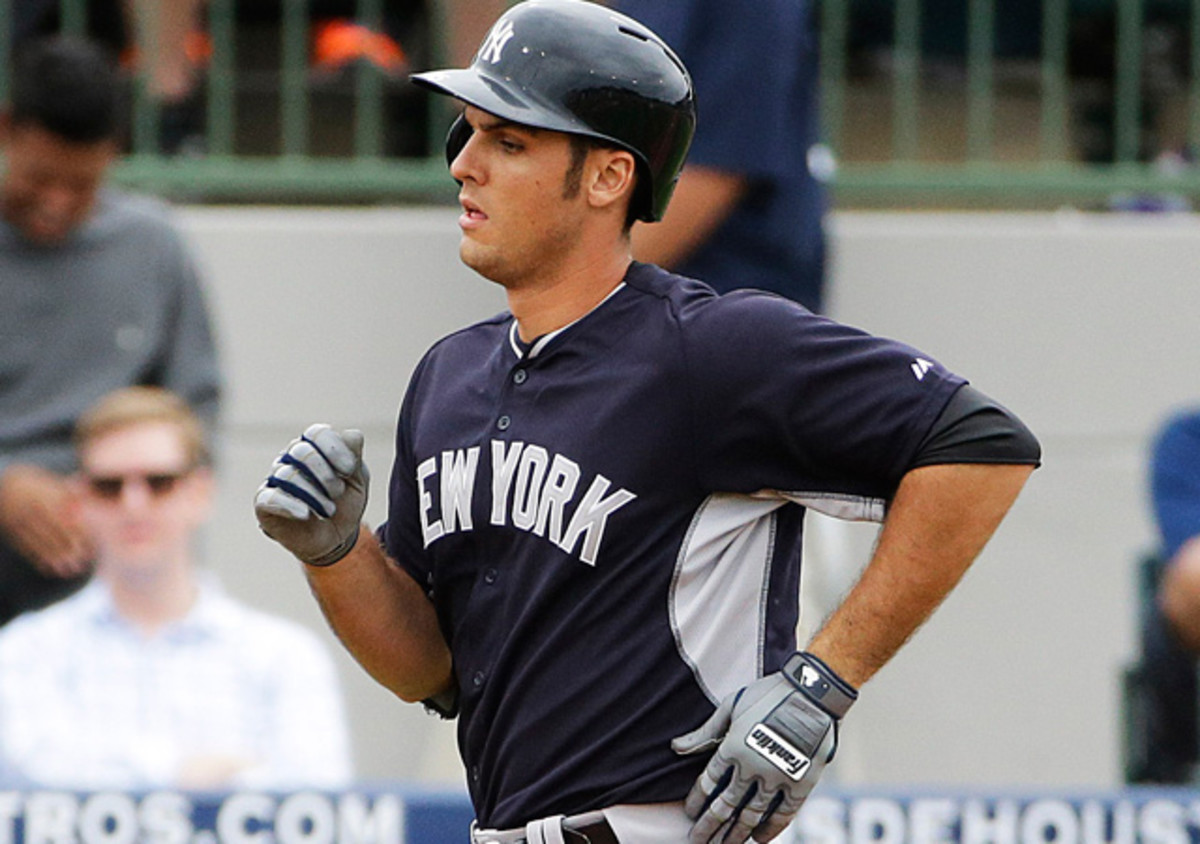Hit and Run: Sano powers up for Twins; Bird is the word for Yankees

1. Sano's Twin blasts
The Twins have spent the past few weeks slipping out of the American League playoff picture as their pitching has come back to earth, but Miguel Sano has hardly been to blame. On Monday night against the Rangers, the rookie slugger put on a show, clouting home runs into the second and third decks of Target Field and driving in six runs in an 11–1 victory.
After singling off Nick Martinez in the first inning, Sano faced him again in the third with a runner on second. Martinez left an 89-mph fastball on the inside corner of the plate, and Sano pulverized it, sending it an estimated 432 feet into the second deck in left-centerfield. Then, with two men aboard in the fourth inning, Sano battled until the sixth pitch, an 82-mph changeup that Martinez left in the 22-year-old designated hitter's happy zone. Estimated at 404 feet, the towering shot reached the third deck. Behold both blasts:
Via MLB Advanced Media's Statcast data at Baseball Savant, the exit velocities of the two homers were 108 and 109 mph, respectively. The first of them was the longest of his seven major league homers to date, and the pair made for the first multi-homer game of his career. With a sacrifice fly tacked on in the fifth inning, his six RBIs tied the Cubs' Kris Bryant, the Cardinals' Randal Grichuk and the Marlins' J.T. Realmuto for the most by a rookie this season; Realmuto lit up the Red Sox on Wednesday via a grand slam, an RBI triple and an RBI single. Sano’s six-pack matched games by Oswaldo Arcia, Chris Colabello and Eduardo Escobar for the most RBIs by a Twin since Joe Mauer drove in seven against the Royals on July 26, 2010.
Awards Watch: Kershaw, Price close in on Greinke, Gray in Cy Young races
Recalled on July 2—a fitting date given that as a 16-year-old, the Dominican-born slugger was considered the game's top international prospect, the subject of a bidding war that became part of an acclaimed documentary—Sano has delivered as advertised since joining the Twins, batting .295/.409/.571 for a 167 OPS+ in 137 plate appearances through Wednesday's games. Though he's struck out in 32.8% of his plate appearances, he's also walked in 16.8% of them. Via FanGraphs, his 27.2% rate of swinging at pitches outside the strike zone is in the lower third of the 383 players with at least 100 PA this year, comparable to Mike Trout (26.6) and Joc Pederson (27.3). His 42.2% swing rate is in the lower sixth of that group, which is to say that he's a very selective hitter, albeit one with some holes in his swing; his 78.3% zone contact rate is in the lowest fifth percentile (19th out of 383), albeit ahead of Bryant (77.0) and Chris Davis (76.5), two sluggers to whom he's drawn comparison.
Listed at 6'4", 260 pounds, Sano has largely been limited to DH duty, making just four starts at third base with a one-inning spot appearance at first. That's less a judgment on his defensive skills (though his glove isn't his forte) than the fact that he missed all of last season due to a torn ulnar collateral ligament that required Tommy John surgery, not to mention the presence of incumbent third baseman Trevor Plouffe, a solid fielder and one of the Twins' more productive hitters. For now, it's just fine, as his bat is the show.
Hisashi Iwakuma's no-hitter provides bright spot for struggling Mariners
Alas, the Twins have gone just 16–19 since recalling Sano, including just 8–16 since the All-Star break. They finished the first half at 49–40 for the league's second-best record behind the Royals, but since then, they own the league’s second-worst mark, just one half-game better than the lowly Red Sox. That's dropped them from 4 1/2 games back in the AL Central to 11 back, and from the AL wild-card lead to a two-game deficit in the race for the second spot.
Minnesota isn't out of it, but amid that second-half slide, the team's pitching has been tattooed for 5.95 runs per game. In one five-game stretch against the Blue Jays and Indians last week, all five starters—rookie Tyler Duffey, Kyle Gibson, Mike Pelfrey, Ervin Santana and Phil Hughes—offered up disaster starts, with more runs allowed than innings pitched and a collective ERA of 20.68; only Gibson made it into the fifth inning. The Twins will have to do better than that to hang in the race, but whether or not they do, Sano is a sight to behold.
• JAFFE: Picking likeliest landing spots for Chase Utley at waiver deadline
2. Rizzo's reach
Cubs first baseman Anthony Rizzo made an incredible catch of a pop foul off the bat of the Brewers' Ryan Braun on Wednesday night at Wrigley Field, scaling the tarp and stepping into the stands as he made the grab. As great as the play was, initially there was more than a little confusion as to whether he was within the rules. Watch:
Initially, the umpires ruled that Rizzo had left the field of play to make the grab, a violation of Rule 5.09(a)(1), which reads:
A fielder may reach into, but not step into, a dugout to make a catch, and if he holds the ball, the catch shall be allowed. A fielder, in order to make a catch on a foul ball nearing a dugout or other out-of-play area (such as the stands), must have one or both feet on or over the playing surface (including the lip of the dugout) and neither foot on the ground inside the dugout or in any other out-of-play area. Ball is in play, unless the fielder, after making a legal catch, falls into a dugout or other out-of-play area, in which case the ball is dead.
The question was whether Rizzo had stepped out of play before making the catch and landing among the fans in the stands, in which case the result would have been just a foul ball. Upon huddling, the umpires ruled that Rizzo was still in bounds when he caught the ball, but by landing in the stands, the runner on first base (Jonathan Lucroy) was allowed to advance to second. The Cubs, who led 2–1 at the time, held on to win 3–2 for their 12th victory in 13 games.
• REITER: Yankees' running game grinds to halt at bad time

3. Bird is the word for flailing Yankees
The Yankees' 41-day run in first place ended not with a bang but a whimper on Wednesday night, as the team lost 2–1 to the Indians in Cleveland. It was the team's sixth loss in seven games, a span during which they've scored all of nine runs while "hitting" .157/.235/.246. Of course, the drought comes on the heels of a 7–3 stretch during which the Bronx Bombers bashed out 90 runs and raked at a .309/.309/.571 clip. Some kind of regression was due.
Manny Machado dazzling, starring at 3B—and he's still getting used to it
While the team's 4.77 runs per game still ranks second in the league behind only the Blue Jays (who now lead the AL East by half a game), the Yankees are reaching into their farm system for help. They've recalled 22-year-old first baseman Greg Bird from Triple A Scranton/Wilkes-Barre, essentially to replace the recently designated-for-assignment Garrett Jones. He'll join them in Cleveland and spend time backing up Mark Teixeira and Alex Rodriguez, the team's two most productive hitters this year (30 homers and 154 OPS+ for the former, 24 homers and 148 OPS+ for the latter), but who are nonetheless old enough (35 and 40, respectively) that the occasional August breather makes sense, particularly during a stretch of 16 straight days with games. The two sluggers are coming off monster July showings, each with an OPS north of 1.000, but in the small sample of August, they're both south of .600.
A fifth-round pick out of a Colorado high school in 2011, the lefty-swinging Bird entered the season ranked among the team's top prospects (second via ESPN, fourth via Baseball America, seventh via Baseball Prospectus). He finished last season and began this one at Double A Trenton before moving up to Triple A on July 4. Overall, he's hit .277/.356/.469 with 12 homers in 362 PA, including .301/.353/.500 at the higher level.
Bird, who was labeled “untouchable” at the trade deadline, caught the attention of Rodriguez this past spring. Via the New York Daily News' Mark Feinsand, he said, "You see the way the ball comes off his bat. Then you see his work ethic, and how he watches and asks smart questions, and you know he’s got a great makeup. He’s going to be around for a long time."
ESPN's Keith Law, who ranked Bird 80th on his Top 100 Prospects list, had this to say about him in January:
Bird's swing is very short to the ball, and he accelerates his hands quickly for hard contact to all fields, rarely putting the ball on the ground because he squares it up so frequently. He's a high-IQ hitter with outstanding plate discipline and understanding of how to work a pitcher, giving reason to think he'll continue to post high OBPs even though he'll probably hit only .250-260 with a lot of strikeouts.
More recently, BP's Jeff Moore wrote of Bird:
Scouts who like toolsy athletes have stayed away from Bird because, well, that’s not him. What he does have, however, is plus raw power and an advanced approach that lets him tap into it. He doesn’t have elite bat speed, but he has enough, and he boasts the on-base ability to make up for a merely average hit tool.
Bird, who's being groomed to replace Teixeira when his contract expires after next season, isn't going to save the Yankees' season. More likely, he’s just up for this packed stretch of games and then could return in September once rosters expand. Even so, he could provide a bit of punch for a team that’s sorely lacked it over the past week.
